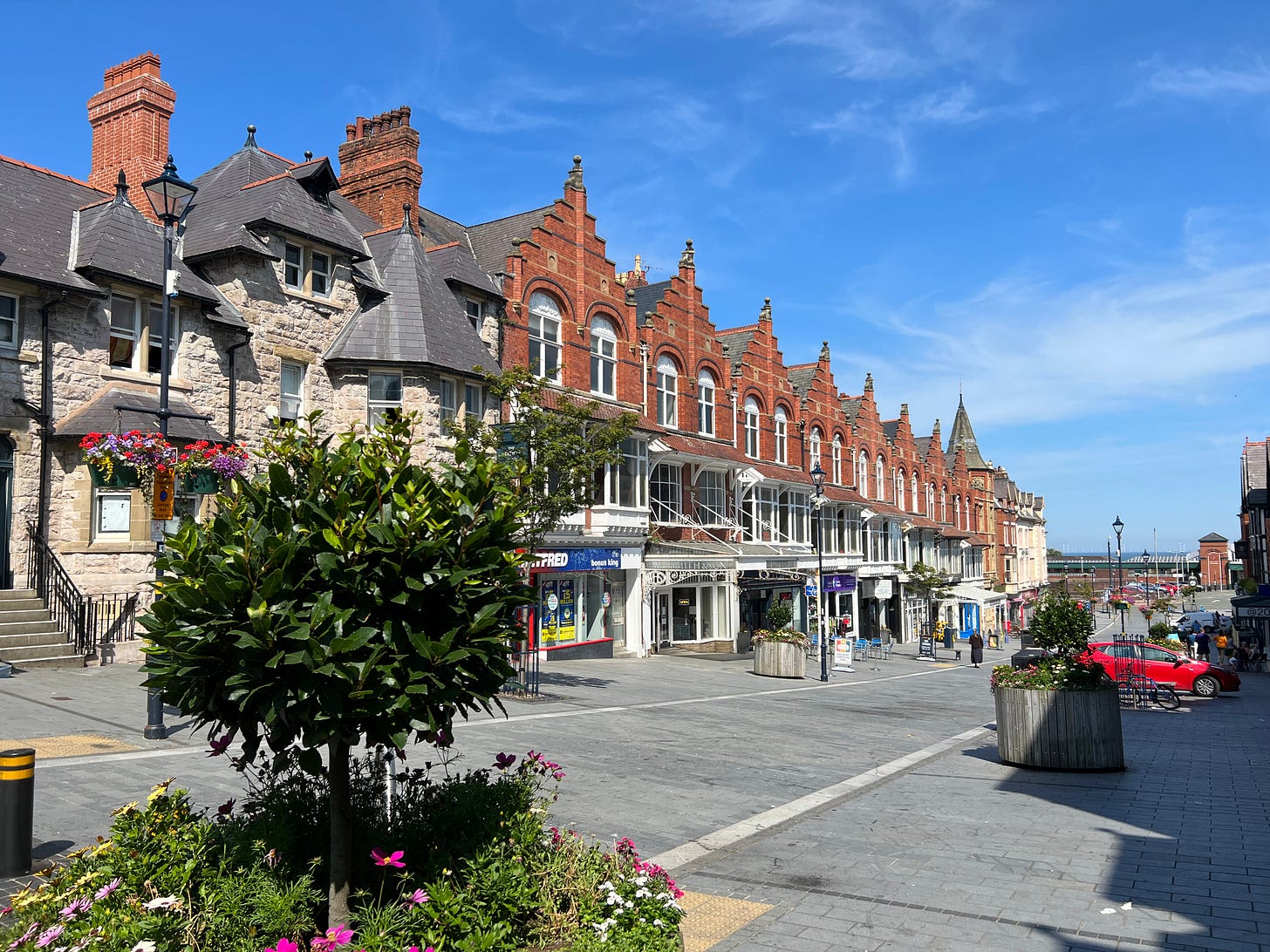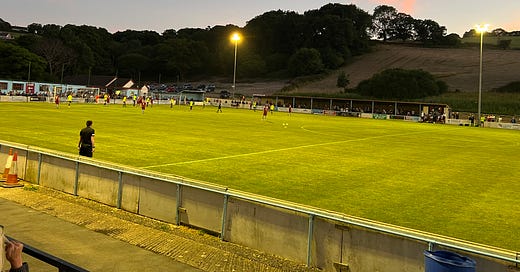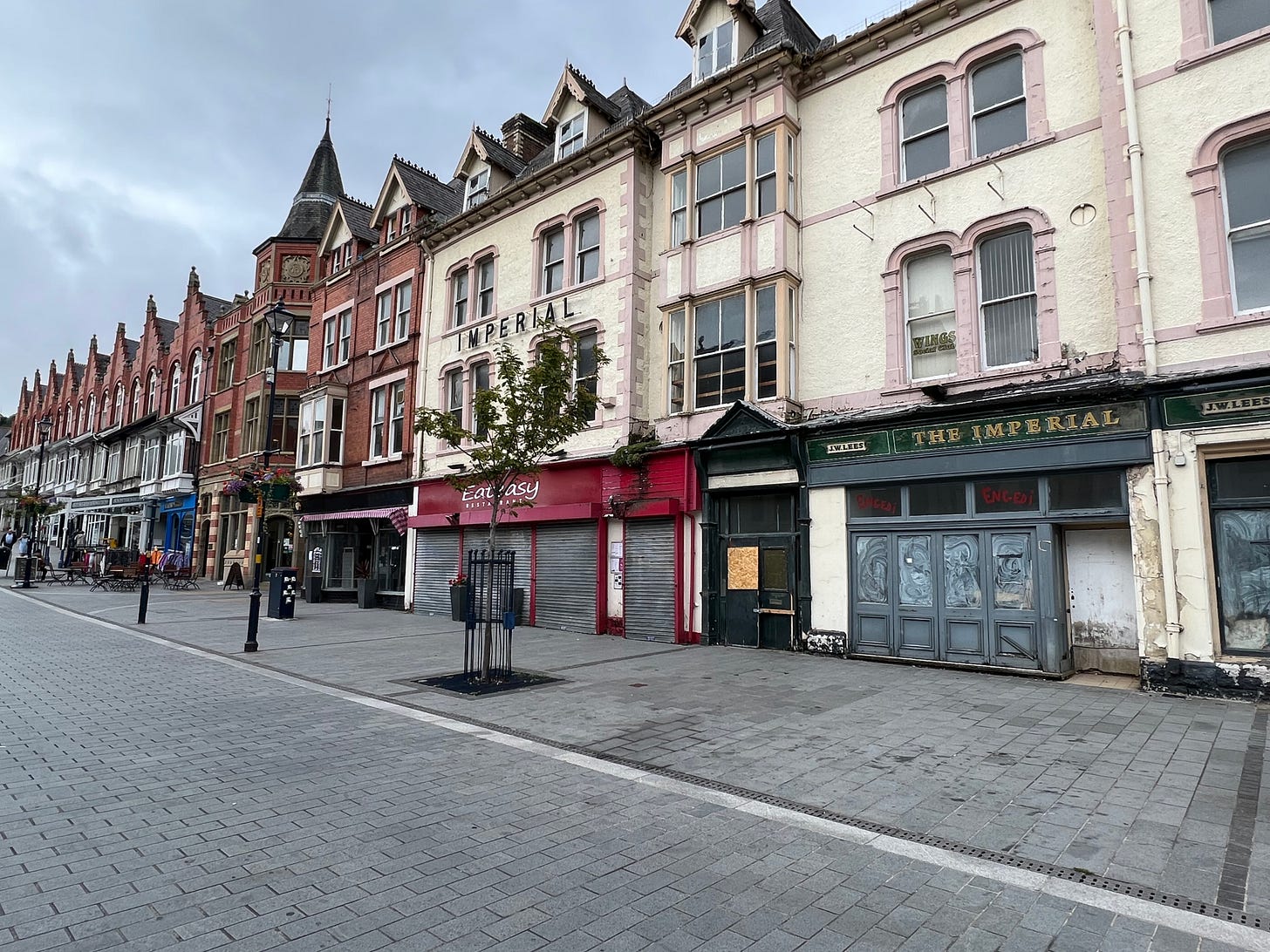For the most part, Gelsey has been providing our “lifestyle” posts, and I’ve been writing the high literature of adverb-laden posts about junk food. After 3 weeks in Colwyn Bay, however, I thought I’d provide a few of my own observations about the place to supplement Gelsey’s overview of what it’s like for us to live here.
Like Gelsey noted, the first thing that stood out to us was how quaint the town is. It has a nice pedestrian strip, some good cafes and restaurants, and the impressively long and wide beach. These seem like the ingredients for a great tourist town.

But it’s not the tourist town, because Llandudno is the tourist town. The major contrast between the two towns is the accessibility of the beach. The town of Colwyn Bay is separated from the beach by both the North Wales Expressway and railroad tracks. It should be noted, in neither the town nor along the beach does the presence of the transit arteries disrupt life, but it separates the two from each other.
Llandudno has a lovely “beachfront” promenade, beach here in scare quotes because there is hardly any sand. It’s nicer to walk down the Llandudno promenade if you want to look at the buildings. It’s nicer to walk down the Colwyn Bay promenade if you want to look at the beach.
There are, I suppose, those who would disagree with my assessment about the vistas as well because another distinguishing feature of Colwyn Bay’s beachfront is the offshore wind farm. I actually find the rows of windmills in the distance a lovely way to break up the otherwise perfectly straight horizon line, but I know there are those who find them to be eyesores.
Gelsey highlighted the nicest things about Colwyn Bay. There is the café, Haus, where we have come once or twice a week to read and write (and from where this post is being drafted). The grocery store, Morrisons, is the closest we have come to the grocery stores we’re used to (although the Billa Plus in Vienna was also quite nice). And our living situation is excellent.
The people are also unvaryingly friendly. Wherever we go, we are assailed with the local greeting, “are you okay?” The ‘ay’ half of the last word seems to drag on nearly endlessly, with about three distinctly different vowel sounds as people roll the word out of their mouth with their tongue. At first I thought I must have done something boneheaded like put my English pants and American pants on in the wrong order, but I was giving off no such air of obvious confusion or unwellness. This is simply the local form of “hi, how are you?”
At the cafes, the operators clearly know groups of regulars. We overheard the owner of Haus explaining to one of the (evidently new-ish) servers here about Tony, who comes in a few times a week to get two cappuccinos for takeaway. Two weeks later, Tony came in (toting his own coffee carrying tray) while were working and the barista just made him his two cappuccinos.
At Caffi Colwyn (our Monday hangout, since Haus is closed), the chef who also seemed to be in charge of the place and gave off extremely strong Mrs. Pattmore1 vibes, knew a bunch of young women who all seemingly arrived after an exercise class. When we inquired about scones (which were on the menu but not in the pastry case), she said she hadn’t made any yet this week because she had to throw a bunch away last week. We asked if she would make some later today (or tomorrow) if we promised to come back. Having thought we had agreed to that, she made them right then and we got hot scones fresh out of the oven. We took two more to go as a sign of appreciation.
This friendliness even extended to people’s recurring interactions with us. I had gotten to talking to the cabbie who took us from the train station to our accommodations about football. (When he heard we were based in DC most recently, he said something like, “Wayne Rooney’s just gone there, hasn’t he?”) He mentioned the local team, Colwyn Bay FC, to which I responded I hoped to get to a match while we were here. He told me to come the next Tuesday, so we did! And he recognized us! And said hello! And then joked with his mates that we were a couple of DC United fans!
But the town also has many obvious signs of struggle. On our last trip to Caffi Colwyn, we overheard conversations about both the closing of Chicago’s, an “American-style” café that no longer exists, and a tailor’s that had seemingly closed. Those are by no means the only vacant storefronts.
Gelsey shared the photo of the lovely pedestrian street from the top. At the other end, there are three vacant storefronts in a row, including a large good-bones structure right on the corner that has all the potential to be beautifully restored. In all, there 8 vacant storefronts on this street – for our money, the nicest in town.
And it’s not like the storefronts that are occupied signal a vibrant local economy. Two of the non-vacant storefronts are betting parlors, another is a sad-looking arcade. One is a Christian lounge. There are a few charity chops. And there are several tourist shops in a pretty sorry state of upkeep offering only the cheapest recreational plastic for beach-going. It’s not great.
What’s more, while the pandemic might have caused some of these vacancies, many more seem to have been vacant for some time. There’s still a storefront bearing Thomas Cook’s (bankrupt in 2019) name and insignia. Other buildings appear to have been vacant for longer.
Any neighborhood is going to have its share of vacant storefronts. Even in the affluent DC neighborhoods of Woodley Park and Cleveland Park there were always a few vacant storefronts. But the occupied storefronts in Woodley and Cleveland Parks were places I could imagine frequenting (or actually did). Here most of the occupied storefronts are furniture stores, hair/nail salons and barbershops, tourist stores, or sad looking takeaway places.
Speaking of takeaway places, we’ve only risked our health at two: a fish-‘n-chips place recommended by the teenage daughters of our hosts and a Bangladeshi takeaway further up the hill by a quite nice pub that has somehow so far escaped either of our descriptions (Gelsey attests it will be mentioned in an upcoming gastronomy post). We thought we might have to patronize Tony’s Plaice2 just for the pun, but its 1/5-star review on Google and 1/5-star hygiene rating made us reconsider. We went instead to the Bay Grill and had what are unequivocally the worst fish and chips I’ve ever had. The Bangladeshi takeaway was excellent however.
There are many more takeaway places we are unlikely to try (a couple of burger/fish-‘n-chips/kebab/pizza places) and another Indian takeaway (where our hosts told us they make a chicken tikka mozzarella curry, which sounds too ridiculous to be believed, so naturally, with more time here, I would have wanted to try it).
All in all, Colwyn Bay feels like a working class town that’s struggling. And it’s not really a surprise that a working class town would be struggling. Inflation is over 10% here and still going up; it’s projected to crest above 18% early next year. The NHS is breaking; funding cuts and more affluent people paying for private medical care will have compounding effects. The cost-of-living crisis (enough of a thing to be its own tag on the Financial Times website) is driving strikes, the most consequential of which have been rail and transit workers. From these strikes there are knock-on effects of people not being able to get to work or travel to events. Solidarity with the strikers, of course!
The challenging times serve, in my mind, only to reinforce the exceptional social grace and niceties of the people here. Life is hard at the moment and yet Mrs. Pattmore’s doppleganger can still kibbutz with the young women about their trip to Turkey or their exercise class. Tony still comes to get his cappuccinos for takeaway. And everyone still asks enthusiastically if we are okaaaaiiiyyyeee.
For the uninitiated, Mrs. Pattmore is the chef at Downton Abbey, the popular British period drama about the aristocrats and staff at the eponymous country estate in the early 20th century.
This is, obviously, a fish and chips joint.





